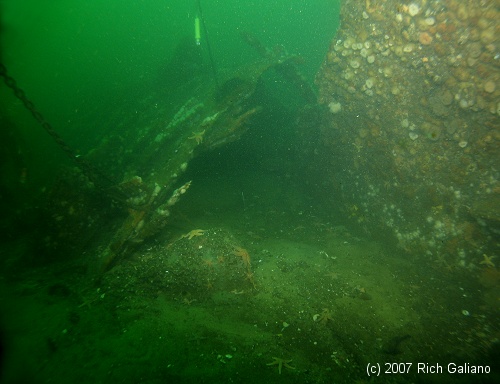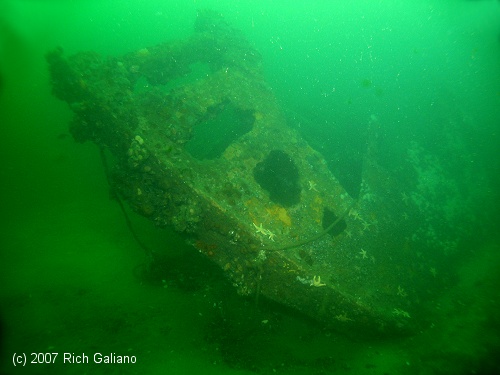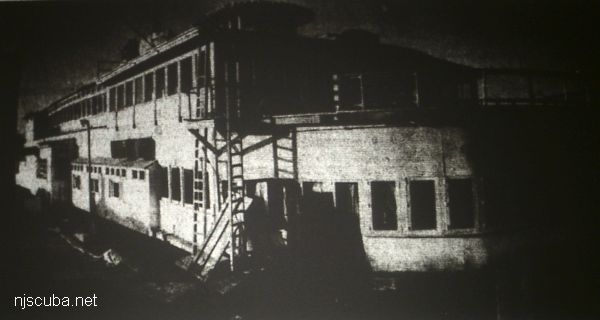Cranford (2/2)

The remains of the Cranford are well broken down. In poor visibility, the Cranford seems like a junkyard, but in good visibility, it is possible to make out the layout of the ship. Curved sections of the hull jut up from the sand along either side of the wreck. Parts of the hull ribbing still stick up 10 ft or more. The main hull structure was iron, but most of the decking is wood. The propellers lie buried in the sand at each end, with just one blade protruding, inside tunnels formed by the collapsed hull.
The edges of this expansive wreck can be followed all the way around the sandy interior, giving this reef its nickname - "The Sandbox". Much decking and debris also lies inside the walls, mostly metal, and some wood. In the center of the wreck, the engine and boiler room can be found by a thick layer of fire bricks and iron gratings. Depending on the shifting sands, you can also find the propeller shafts. The Cranford is an excellent spearfishing site; much less good for lobsters. The Cranford makes for a great night dive.

Cranford's elder near-sister Elizabeth in drydock. This picture shows the broad double-ended hull form and propeller to good advantage.

Partial side-scan sonar image. Since the Cranford was a double-ended ferry, you would expect the missing part of this side-scan to be pretty much the same. The 205 ft length that had always been quoted for this wreck is wrong.



The north end of the wreck. The crooked round object at the lower-right is the top of the rudder shaft. The dark arch at the left is the entrance to the tunnel that encloses the propeller. The hull had an extreme overhang here, and the deck beams have collapsed.









Dismantled Brielle Ferry Scuttled 4 Miles off Coast

BY BOB WARE
Press Staff Writer
Brielle - the Cranford, a once-proud commuter ferry reduced to a bare and rusting hulk, sailed her last voyage yesterday under the power of a pair of tugboats named Ingrid Ann and L'il Toot. The two tugboats, their diesel engines spurting black smoke, pushed, pulled, and prodded the Cranford from her muddy berth of 17 years at the Brielle Yacht Basin at about 11:45 AM.
A handful of spectators watched from the Route 35 bridge and the North Coast Line railroad bridge, as the tugs negotiated the ferry through the Manasquan inlet. Of particular interest was the ferry's passage through the railroad bridge opening. The Cranford struck the bridge on April 21, 1965, as she first entered the inlet. The Coast Guard escorted the vessels through the Manasquan Inlet at high tide.
Four miles out, under an overcast sky, valves to the 205-foot hull were opened, and it sank in about 65 ft of water to become part of an artificial reef, said Petty Officer Roy Lindner of the Coast Guard station at Manasquan. The Cranford sank bow-first in about an hour and a half, according to David Bogan, captain of the party boat Paramount that is based here. Bogan helped the tug boats locate the artificial reef, commonly referred to as the Sea Girt Artificial Reef, using an electronic position-finding device.
The sinking ended a dispute between borough officials and the Cranford's owner over the removal of the rotting ferry, which had become an eyesore after serving more than a decade as a restaurant. George Mauro, a Dixieland musician and showman, purchased the ferry in 1965 from the old Central Railroad of New Jersey, which had used it for 60 years to ferry commuters between Jersey City to Manhattan. Mauro sailed the ferry from Jersey City to the Brielle Yacht Basin and converted it into the Ferry Boat Restaurant. Mauro sold the supper club to George and Alexander Kalivas, principals of the A.G. & S. Corp., Oradell, in 1971. The brothers operated the restaurant through 1979, when they decided to relocate the ferry.
But the state Division of Marine Services, with the 1965 accident in mind, insisted on a meeting among owners, Coast Guard, and the Army Corps of Engineers. The meeting was never held, and the boat stayed where it was. In 1979, about 2 1/2 acres near the ferry and the ferry's liquor license were sold to Ashley Development Corp., Brielle. The ferry remained at the hands of the Kalivas brothers.
The unused ferry became an object of vandalism, and borough officials began pressing for it to be moved. The Kalivases said they could not find a buyer for the ferry. Ashley foreclosed on the boat about a year later and took responsibility for about $40,000 which the Kalivases still owed creditors.
Ashley sold the boat a year ago yesterday for $1 at a borough auction. The new owners, Robert Hager, owner of H & R Welding, Brick Township, and Richard Hazelet, owner of Security Fence Co., Point Pleasant, cut and sold much of the superstructure for scrap. Yesterday, they used two tugs to dispose of what was left.
Although still a tight fit, the ferry cleared the 48-foot-wide railroad bridge opening. In 1965, the 1, 129-ton terry, while traveling under its own power as it approached at high tide during a full moon, struck the north span of the bridge. The accident caused an eight-hour delay in rail traffic.
Arthur Dixon, a principal of Ashley Development, said the removal of the ferry is important to the corporation's plans for development of the waterfront area. By May, he said, the company wants to remove the deteriorated ferry boat walkway and rebuild an existing dock underneath. The dock will add about 40 slips to the Brielle Yacht Basin, he said. Within a few years, Dixon said, the corporation hopes to have existing docks replaced with floating docks.
The Eggers Group and the Grad Partnership, both architectural firms, have prepared site plans for 8.6 acres Ashley owns on the waterfront. Dixon said the plans include a 400-car underground parking area with a park on top, about 70 housing units consisting of luxury condominiums, penthouses, and duplexes, and another structure with 50 suites for club members. Planned for the roof of the suites, overlooking the ocean are a restaurant and cocktail lounge, he said. If the plans are approved by Ashley as presented by the architects, the corporation may present the plans to borough officials in two to three months, Dixon said.
Asbury Park Press
March 31, 1982

An undignified end for the sole remaining CRRNJ ferry Elizabeth. Sunk as a reef in 2005
Historic photos courtesy of Liberty State Park


Questions or Inquiries?
Just want to say Hello? Sign the .